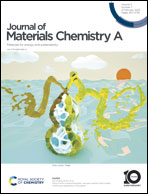Mapping polymer donors with a non-fused acceptor possessing outward branched alkyl chains for efficient organic solar cells†
Abstract
Developing non-fused-ring electron acceptors (NFREAs) is a promising strategy toward high-efficiency and low-cost organic solar cells (OSCs), for which an in-depth understanding of the donor:acceptor (D:A) pairing principles is essential. Herein, we designed and synthesized a tetra-thiophene-cored NFREA with outward branched alkyl chains, BO-4T, and performed a systematic study by mapping four polymer donors, namely D18, PM6, PBDB-T, and J52, with BO-4T to investigate the carrier dynamics and molecular packing. It was unveiled that the narrowed energetic offset and broadened absorption coverage of the D:A blends were favorable for maximizing the voltage and photocurrent of OSCs, respectively, and the suitable phase separation induced by the miscibility between the D:A couple was critical for achieving high crystallinity and good charge-transport properties. Finally, with lower energy loss and less charge recombination, PM6 worked the best with BO-4T, demonstrating a high efficiency of 14.33%, which is among the best for OSCs based on NFREAs. Therefore, this work provides valuable guidelines for selecting polymer donors to match NFREAs.

- This article is part of the themed collection: Photofunctional Materials and Transformations


 Please wait while we load your content...
Please wait while we load your content...